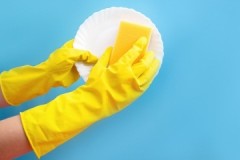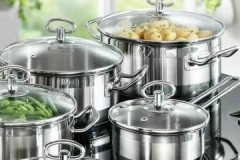Safety question: can I wash dishes with a melamine sponge?
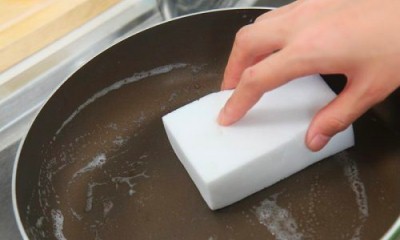 A melamine sponge is a soft abrasive tool that copes well with difficult stains on metal, ceramics, plastic and other materials.
A melamine sponge is a soft abrasive tool that copes well with difficult stains on metal, ceramics, plastic and other materials.
Despite its excellent cleaning properties, it cannot be used on all surfaces. Unlimited use of melamine can be harmful not only to dishes, but also to health.
Is it possible to wash dishes with a melamine sponge or not and why, we will tell you further.
Content
What is melamine?
Melamine sponges are made from foamed melamine-formaldehyde polymer. This material is a good abrasive, sound and heat insulator.
The cleaning properties of a sponge are determined by its structure. When squeezed in your hand, it feels soft and flexible, although at the micro level the polymer particles have very high hardness. Like foam rubber, foamed melamine has a porous structure, but the walls of each open pore are formed not by soft polystyrene, but by hard fibers.
With foamed melanin The following stubborn stains can be removed:
 dried fat;
dried fat;- soot;
- soot;
- mold;
- ink;
- traces of dyes and shoes on floor coverings;
- dense limescale;
- rust, etc.
After cleaning, no streaks, drips or other marks remain on the surface. Inexpensive washcloths consist of a foam base with a thin melamine coating. This washcloth is easy to use, but wears out quickly. More expensive options are made entirely of melamine.
Previously, melamine powder was used as an additive in low-quality food products to simulate high protein content.
Should I use it for washing dishes?
Melamine sponge It is not recommended to use for washing any surfaces that come into contact with food.. Even small doses of this substance that remain on clean dishes after washing can cause chronic disease over time.
The outside of pots and pans does not come into direct contact with food, so you can rub it with melamine. To avoid getting plastic particles on other dishes, you can clean off carbon deposits over a bathtub or a separate large container.
Why is melamine dangerous?
According to chemical classifications, melamine is classified as a material with medium or low toxicity. The average lethal dose of this substance is greater than that of caffeine, paracetamol and even kitchen salt. However, acute toxic effect is not the only criterion for assessing the safety of a material.
This is due to the fact that when the substance is excreted, it accumulates in the kidneys, causing the formation of urinary stones and degradation of the renal tubules.
In an experiment with rats, it was found that significant doses of melamine can provoke the appearance of bladder carcinomas. The occurrence of tumors may be associated with the formation of kidney stones and constant irritation of the mucous membrane by abrasive crystals.
Due to small doses of polymer in humans, these side effects are less pronounced. Despite this, in the USA, the European Union, the Russian Federation and other countries it is prohibited to use melamine tableware for food purposes.
Short term side effects
Small sponge particles can cause respiratory irritation. When cleaning surfaces for a long time, you need to wear protective gloves and a respirator (mask). Contact with abrasives in the eyes causes dryness, irritation, lacrimation and inflammation of the cornea.
When heated, melamine-formaldehyde polymers release harmful fumes containing cyanide, ammonia and various nitrogen oxides.
Is the product useful in the kitchen?
Despite the fact that melamine is prohibited for washing dishes, you should not immediately remove it from the kitchen. With this inexpensive abrasive The following surfaces can be cleaned:
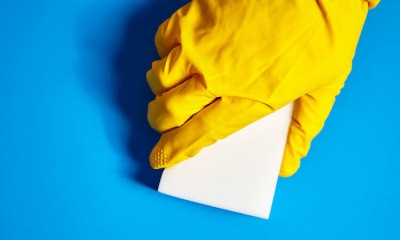 Washable wallpaper (the coating must be suitable for wet and cleaning and resistant to abrasion).
Washable wallpaper (the coating must be suitable for wet and cleaning and resistant to abrasion).- Floor and wall tiles.
- Skirting boards and doors.
- Kitchen furniture.
- Plastic sockets, switches and organizers.
- External parts of household appliances (multi-cookers, bread makers, hobs, etc.).
- Plastic window sills and windows.
It is recommended to use melamine sponges only for general cleaning and for complex spot stains. For everyday care of kitchen surfaces, you should choose safer products. After cleaning with melamine, thoroughly wash the surface with a damp cloth and rinse with water.
Before using the sponge you must:
- divide a large piece of polymer into several sponges, convenient for spot cleaning;
- soak the material in cool or lukewarm water for 3-5 minutes;
- Gently squeeze in your palm without twisting or stretching the sponge.
After this short preparation, the product is ready for use. There is no need to apply soap or dish gel to it. If the surface is wet with detergent, you should rinse the work area before using the sponge. After cleaning, rinse thoroughly and dry the remaining washcloth.
When using melamine sponge forbidden:
- Apply chlorine-containing products (“Belizna”, “Domestos”, etc.) to it.
- Wash surfaces with hot water, heat a sponge or dry it on hot appliances.
- Intensively squeeze, twist, crumple the material.
- Handle hot pots, hobs, etc.
Products should be stored in closed packaging, away from food, sunlight and heat sources.
What else is not recommended to clean?
In addition to dishes, a melamine sponge The following surfaces must not be cleaned:
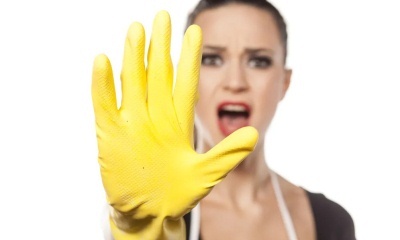 car paint coatings;
car paint coatings;- Kids toys;
- animal bowls;
- oven interior;
- Teflon;
- glossy plastic coatings;
- things painted with unstable dyes or varnish.
Harsh abrasives can leave marks on thin glass and crystal.
What is better to use?
For regular dishwashing It is recommended to use the following types of sponges:
- foam;
- cellulose with antibacterial impregnation;
- silicone;
- microfiber cloths.
To remove stubborn dirt, abrasive (hard) scourers and metal scrapers are used. An important condition for the safety of products is their timely disinfection.
Video on the topic of the article
The video will tell you what qualities of melamine sponges advertising and manufacturers do not tell you about, and whether they are safe to use:
Conclusion
Therefore, washing dishes with a melamine sponge can be dangerous, especially in the long run. To avoid side effects, you should only clean surfaces that do not come into contact with food. If safety precautions are followed, the material does not cause harm to health.
